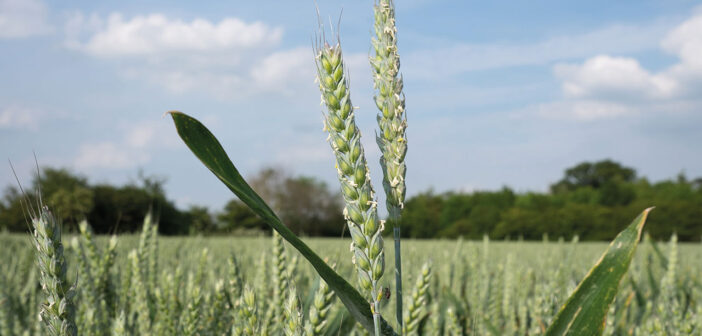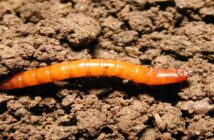Following a reasonably wet winter, winter wheat is moving towards growth stage (GS) 32 pleasantly clean in Agrii agronomist Todd Jex’s area of Hampshire, Wiltshire and Dorset.
Much of it was drilled from November onwards and, as a result, septoria levels are not as significant as last season. The cold snap at the end of February also checked brown rust, even in the more susceptible varieties.
However, Todd points out that growers shouldn’t assume too much at this stage. Late-sown, resilient varieties do offer some scope when it comes to fungicide choices and rates, but he reminds growers of previous seasons where the weather changed quickly, only for disease pressure to do the same.
“In previous seasons, we’ve seen T1 rates reduced or even a switch away from premium azole combos in the absence of septoria. Then the weather turns and the mix lacks the potency and persistence to protect until the T2.
“In the past that wasn’t such an issue, as growers could ‘get out of jail’ with several eradicant options. Unfortunately, this isn’t the case any more, nor do we have chlorothalonil to protect new growth.”
He also says that despite the cool spell in March, later-sown crops will be more prone to yellow rust, especially varieties with poor juvenile resistance.
Exceptional gout fly pressure
Septoria might be absent in later-drilled crops, but gout fly isn’t. Todd considers the numbers ‘exceptional’ this season.
With few options open to growers, he fears significant tiller damage and thinned-out crops. He advises growers to consider rolling and pay particular attention to nitrogen and phosphorus availability, as late-drilled wheats won’t have developed root systems, and frost has lifted up roots to the surface. “Cold winds have seriously damaged some crops. It will be important to improve plant anchorage and stimulate tiller production.”
Todd has been pleasantly surprised by the lack of grassweed pressure. Last harvest was one of the worst he had seen for grassweeds and he expected severe pressure this season. However, it isn’t as bad as he feared, although some growers have turned to the plough or power harrow given the combination of difficult drilling conditions and compromised autumn treatments.
“Last harvest it certainly felt like we had taken a backward step with grassweeds, particularly blackgrass and Italian ryegrass, but generally the level in following crops isn’t as bad as I first feared. Some of the new chemistry, like cinmethylin, has worked well.”
Where grassweeds have come through autumn, a residual tidy-up based on a sulfonylurea herbicide will be applied.
High BYDV levels in barley
Barley yellow dwarf virus (BYDV) is more visible in some wheat varieties this season, but especially in early-drilled barley. Todd says it is a reminder of the importance of variety tolerance or resistance. He notes fields of Syngenta’s Hyvido Neo hybrid Kestrel are much greener than other varieties.
As tolerant and resistant varieties come through in wheats, he believes growers should give them serious consideration, despite gross output scores being lower than the best.
Also visible is the pigeon damage in oilseed rape this season. It has decimated crops and some will be lost. Those crops that are intact at the growing point should be worth saving, assuming the pigeons start to move on to other food sources. But growers will have to load nitrogen rates to build crop canopies.
When it comes to pigeon control, Todd says these are limited options. His view is that the birds soon become acclimatised to deterrents, and with a reduced area this season, there are fewer fields for pigeons to select from. Todd considers hawk kite scarers as the most effective control method, but stresses these do need to be moved frequently.
He isn’t convinced drilling early helps. A crop that was at wellie height early in the season has been grazed to almost nothing.
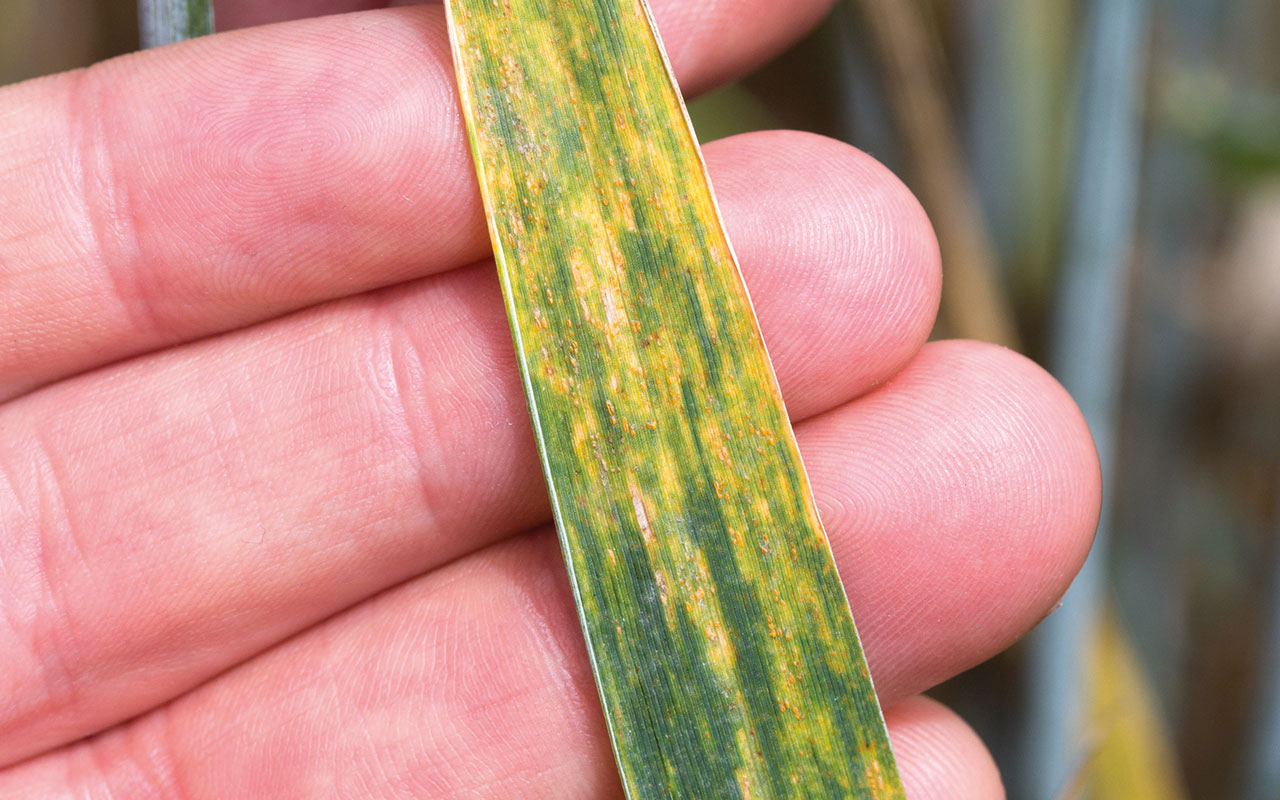
Brown rust has been checked by cool weather
© Tim Scrivener
The situation in the North
Further north, FMC technical specialist Antonia Walker says winter cereals have come out of winter well, with average levels of septoria in winter wheat and some yellow rust in coastal regions.
In winter barley, rhynchosporium is also at relatively low levels. With many barley crops being sown early, Antonia warns growers to keep an eye on it, because if the disease gets away, it can be difficult to regain control. Her advice is to stick with a robust T1, including an SDHI such as Wolverine (metconazole + fluxapyroxad).
Ramularia in barley is always a concern and this coming season will be no different. The disease was reported widely last year in winter and spring crops and Antonia feels growers should consider it as present despite a lack of symptoms.
The disease is particularly hard to identify early on and research has shown it can be asymptomatic for long periods of time during the vegetative growth stage.
“The symptoms of small and irregular rectangular lesions can be misdiagnosed as abiotic stress or even nutrient deficiency. The way to differentiate is that with ramularia, lesions will also show on the underside of the leaf, whereas physiological disorders may only appear on the upper leaf surface area.”
Plant health comes first with barley crops. The healthier the plant, the better it is able to withstand disease and robust early spring fungicide and herbicide applications.
“With reoccuring frosts and changeable conditions, barley tends to show any sensitivity to climatic conditions and subsequent disease and weed control programmes,” Antonia says. She advocates tissue testing regularly through this critical phase of the season, especially with soil temperatures still low.
Even with March fertiliser applications, she considers the weather might still see nutrient deficiencies. One nutrient she expects to be in short supply this season is manganese, an important element for root and shoot development.
“It is also sensible to manage your nitrogen applications carefully, as a lush crop can create ideal conditions for diseases such as rhynchosporum to develop,” she adds.
Potato agronomy pressures
For the region’s potato growers, Antonia says weed control at pre-emergence and early post-emergence timings will be of particular importance.
When planning herbicide programmes growers need to keep the potato crop itself, the following crop and cover crop desiccation in mind. Shark (carfentrazone) offers that flexibility, and her recommendation is to use it either straight or tank-mixed with glyphosate to optimise broad-spectrum control of grass- and broad-leaved weeds.
“It’s clear that carfentrazone has a strong place in the armoury. Its addition will improve control of weeds like nettles. Also pay particular attention to volunteers, as these harbour a range of soil- and seed-borne pathogens.”
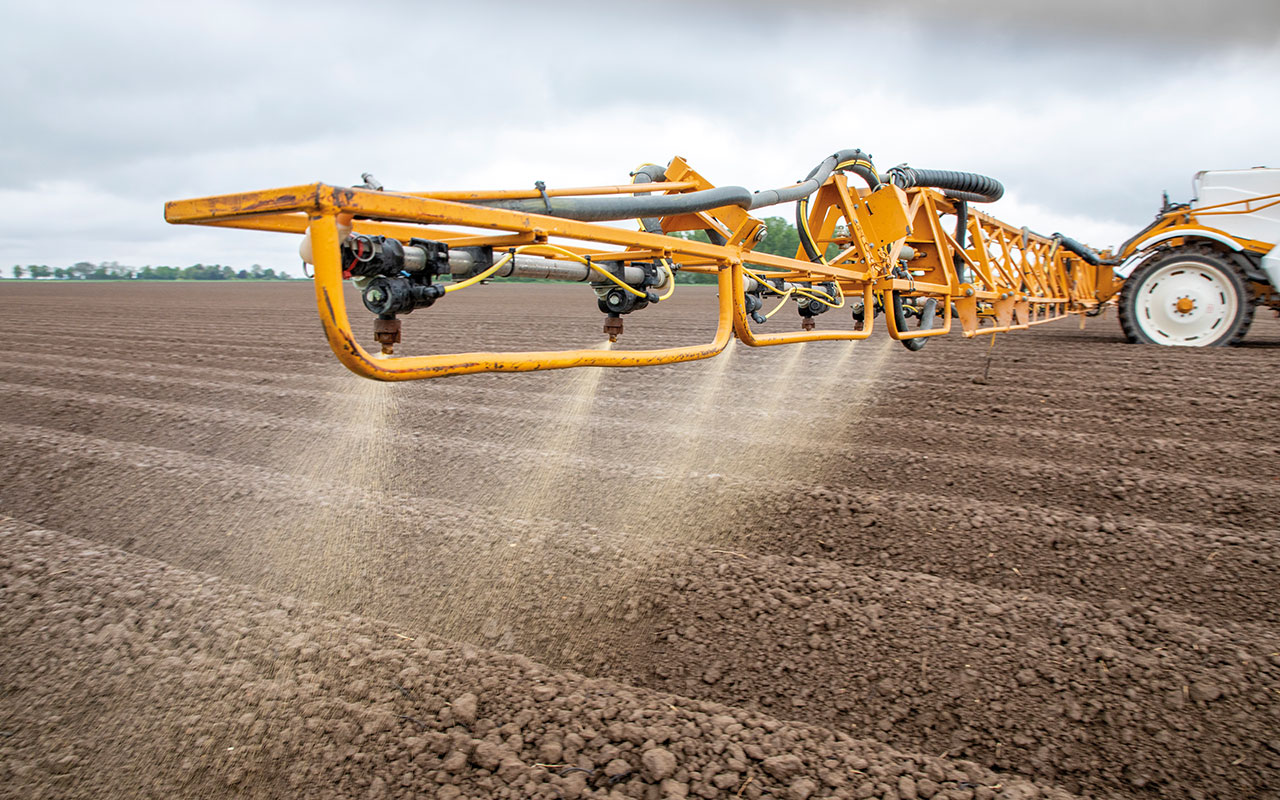
Pre- and early post-emergence weed control in potatoes will be especially important this season © GNP
Aphids are another reason for controlling volunteers. She feels last season was one of the worst for potato leafroll virus.
“We saw a lot of leaf roll last season, and a number of seed potato growers reverted to burndown much earlier. With the restrictions on insecticide chemistry available for seed potatoes, growers need to do all they can to avoid presenting a green bridge.”
Potato cyst nematode (PCN) is another critical issue, and with only three products left for control, it has never been more crucial to include integrated pest management options.
Antonia says the starting point for growers is to pay attention to field history, as well as doing proper PCN testing. She advocates the 1kg/of soil approach preferred by Fera Science.
Its PCN sampling service gives an excellent baseline when it comes to understanding and more accurately determining the eggs per gram of soil and levels of infestation in the field.
Little yellow rust in East Anglia
Ceres Rural agronomist Peter Wilson is seeing little in the way of brown and yellow rust in East Anglia, but feels it will still need to be factored into early-season disease control. He points to last season as a reminder of how quickly disease pressure can change.
Septoria can be found on new tissue, although the lower leaves have been taken off by the frosts of early March. However, it is something growers need to keep an eye on.
Peter says the robustness of T1 applications will depend on the weather ahead of GS32, variety ratings and drilling date. He is unlikely to include a multisite unless septoria pressure ramps up significantly.
Again, it is another season where nutrient deficiency could impair crop health. Due to the dry weather in March, nitrogen hasn’t been washed down to the roots and crops have been slow to take up the first fertiliser application.
This includes backward crops that got a shot of N at the earliest opportunity and were rolled to encourage tillering. Peter advises growers to do soil and tissue tests to check for any deficiencies.
Pigeons have done a huge amount of damage to OSR – the worst he has seen in recent years. Crops are starting to grow away.
Peter feels forward crops that have not been hit hard by pigeons still have good potential and he advises growers to consider canopy management options to achieve the required green area index, and to also keep an eye on light leaf spot infection.
Tailored agronomy needed for variable wheats
Drilling winter wheat in three distinct autumn weather windows means Warwickshire farmer Andrew Keyte has a wide range of yield potential to manage this spring.
Andrew manages Ragley Home Farms in Alcester, Warwickshire. It has 15 soil types, everything from sand to blue clay. “Even though our average field size is just 6-6.5ha, we can go from one extreme to another in a single field,” he says.
Due to blackgrass, Andrew used to hold off drilling until mid-October, but this year he started sowing wheat on 16 September.
However, he had to put the drill back in the shed when it started raining. Apart from a small window around 5 October, the drill wasn’t in the field again until 6 November.
According to local BASF agronomy manager Colin Mountford-Smith, Andrew’s situation is typical of the region.
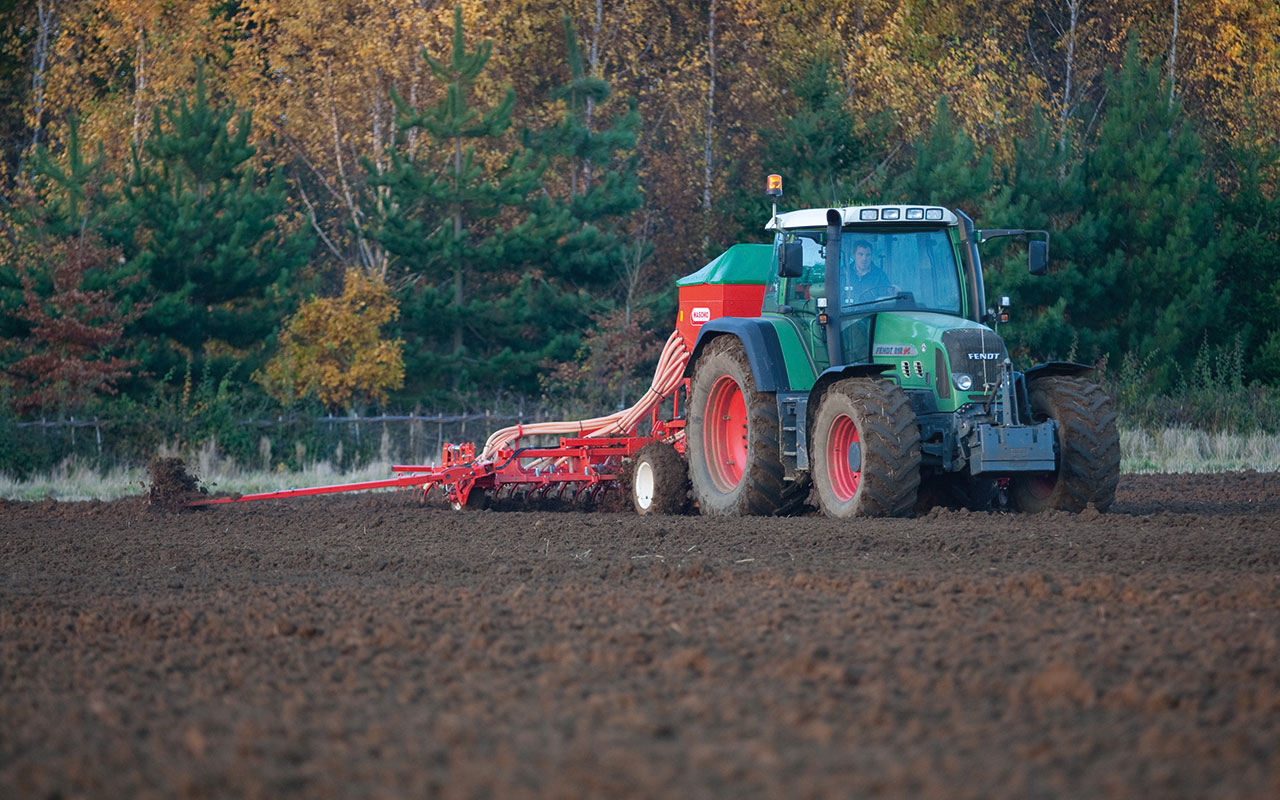
November-drilled wheat is highly variable at Ragley Home Farms © Tim Scrivener
“Most growers in central and West Midlands got their planned acreage drilled this past autumn,” he says.
“The west of the region had a good window early in the season, and again from the middle to the end of October. This was when most of the acreage went in the ground. Andrew is further east, and was unlucky to have this window cut short.
“Unfortunately, at the back end of the season emerging crops faced a lot of rain, leading to some redrilling, or backward or thinner crops.”
While drilling date and weather have been important factors, soil type has often determined how well crops have established at Ragley Home Farms.
“In the main, the September-drilled winter wheat got away well. Some of the Extase even got a bit ahead of itself and we might hold back fertiliser to try to let it catch up. Wheat from this early drilling slot that went into lighter land has suffered with the heavy rain – the soil capped and the crop got wet before it had a chance to establish. It hasn’t recovered,” Peter says.
“The October-drilled crops generally look okay, but the November-drilled wheat is variable.”
Need to tailor fungicide programmes
As well as working out which fields to redrill this spring, Andrew is thinking about his fungicide programme for the season.
With such a wide variety of crops to manage, he will have to tailor programmes depending on yield potential and disease pressure.
“Thinner crops will have as little as possible, but as much as necessary. Those with potential will have whatever they need to keep them clean. With so much of the winter wheat not likely to yield what it should, we need to get the most out of those that will.”
Colin agrees: “With the relatively mild autumn and winter, there is potential for high pressure from all the major diseases this year and anything that was drilled early will be more vulnerable. These crops, in particular, would benefit from the broad-spectrum control offered by Revystar XE [mefentrifluconazole + fluxapyroxad]early in fungicide programmes.”

